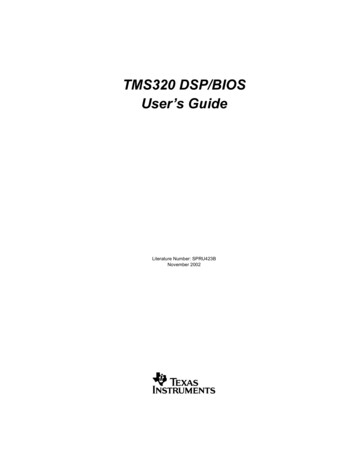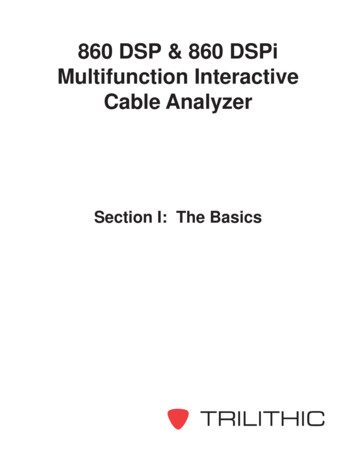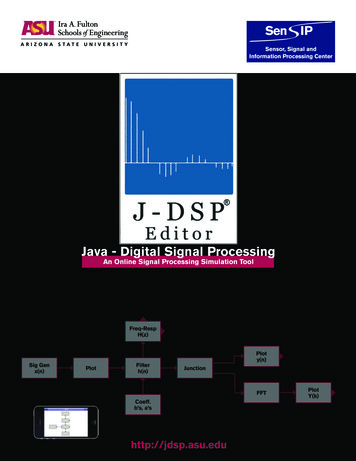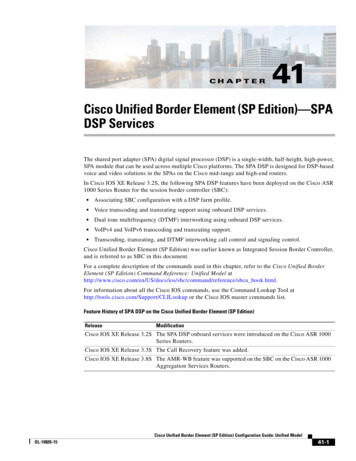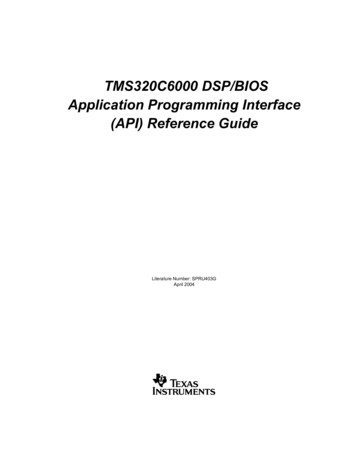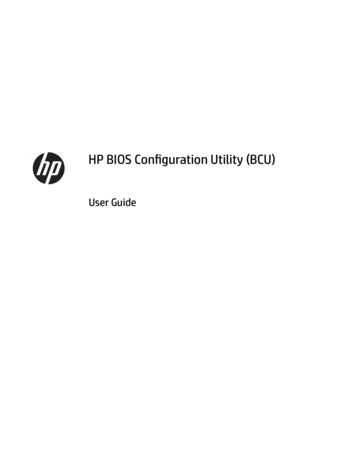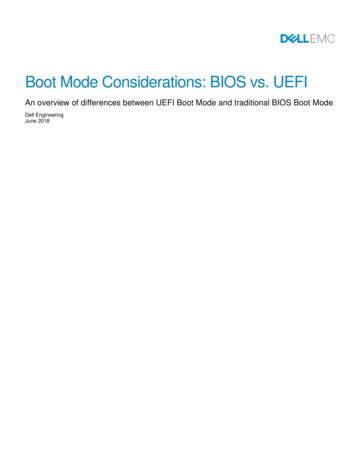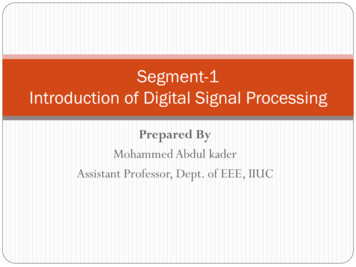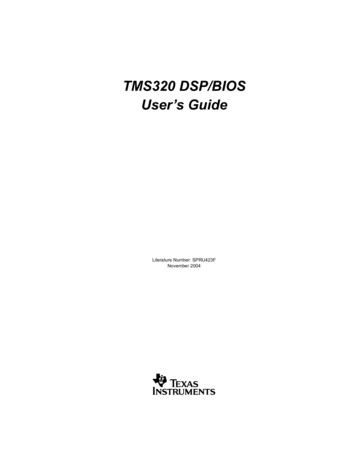
Transcription
TMS320 DSP/BIOSUser’s GuideLiterature Number: SPRU423FNovember 2004
IMPORTANT NOTICETexas Instruments Incorporated and its subsidiaries (TI) reserve the right to make corrections,modifications, enhancements, improvements, and other changes to its products and servicesat any time and to discontinue any product or service without notice. Customers should obtainthe latest relevant information before placing orders and should verify that such information iscurrent and complete. All products are sold subject to TI's terms and conditions of sale suppliedat the time of order acknowledgment.TI warrants performance of its hardware products to the specifications applicable at the time ofsale in accordance with TI's standard warranty. Testing and other quality control techniquesare used to the extent TI deems necessary to support this warranty. Except where mandatedby government requirements, testing of all parameters of each product is not necessarilyperformed.TI assumes no liability for applications assistance or customer product design. Customers areresponsible for their products and applications using TI components. To minimize the risksassociated with customer products and applications, customers should provide adequatedesign and operating safeguards.TI does not warrant or represent that any license, either express or implied, is granted underany TI patent right, copyright, mask work right, or other TI intellectual property right relating toany combination, machine, or process in which TI products or services are used. Informationpublished by TI regarding third party products or services does not constitute a license from TIto use such products or services or a warranty or endorsement thereof. Use of such informationmay require a license from a third party under the patents or other intellectual property of thatthird party, or a license from TI under the patents or other intellectual property of TI.Reproduction of information in TI data books or data sheets is permissible only if reproductionis without alteration and is accompanied by all associated warranties, conditions, limitations,and notices. Reproduction of this information with alteration is an unfair and deceptivebusiness practice. TI is not responsible or liable for such altered documentation.Resale of TI products or services with statements different from or beyond the parametersstated by TI for that product or service voids all express and any implied warranties for theassociated TI product or service and is an unfair and deceptive business practice. TI is notresponsible or liable for any such statements.Mailing Address:Texas InstrumentsPost Office Box 655303Dallas, Texas 75265Copyright 2004, Texas Instruments Incorporated
This is a draft version printed from file: pref.fm on 11/9/04PrefaceRead This FirstAbout This ManualDSP/BIOS gives developers of mainstream applications on TexasInstruments TMS320 DSP devices the ability to develop embedded real-timesoftware. DSP/BIOS provides a small firmware real-time library and easy-touse tools for real-time tracing and analysis.You should read and become familiar with the TMS320 DSP/BIOS APIReference Guide for your platform. The API reference guide is a companionvolume to this user’s guide.Before you read this manual, you should follow the "Using DSP/BIOS"lessons in the online Code Composer Studio Tutorial. This manual discussesvarious aspects of DSP/BIOS in depth and assumes that you have at least abasic understanding of other aspects of DSP/BIOS as found in the helpsystems.Notational ConventionsThis document uses the following conventions: Program listings, program examples, and interactive displays are shownin a special typeface. Examples use a bold version of thespecial typeface for emphasis; interactive displays use a bold versionof the special typeface to distinguish commands that you enter from itemsthat the system displays (such as prompts, command output, errormessages, etc.).Here is a sample program listing:Void copy(HST Obj *input, HST Obj *output){PIP Obj*in, *out;Uns*src, *dst;Unssize;}iii
Related Documentation From Texas Instruments Square brackets ( [ and ] ) identify an optional parameter. If you use anoptional parameter, you specify the information within the brackets.Unless the square brackets are in a bold typeface, do not enter thebrackets themselves. Throughout this manual, 54 can represent the two-digit numericappropriate to your specific DSP platform. If your DSP platform is C62xbased, substitute 62 each time you see the designation 54. For example,DSP/BIOS assembly language API header files for the C6000 platformwill have a suffix of .h62. For the C2800 platform, the suffix will be .h28.For a C64x, C55x, or C28x DSP platform, substitute 64, 55, or 28 for eachoccurrence of 54. Also, each reference to Code Composer Studio C5000can be substituted with Code Composer Studio C6000 depending onyour DSP platform. Information specific to a particular device is designated with one of thefollowing icons:Related Documentation From Texas InstrumentsThe following books describe TMS320 devices and related support tools. Toobtain a copy of any of these TI documents, visit the Texas Instrumentswebsite at www.ti.com.TMS320C28x DSP/BIOS API Reference (literature number SPRU625)TMS320C5000 DSP/BIOS API Reference (literature number SPRU404)TMS320C6000 DSP/BIOS API Reference (literature number SPRU403)describes the DSP/BIOS API functions, which are alphabetized by name. TheAPI Reference Guide is the companion to this user’s guide.DSP/BIOS Textual Configuration (Tconf) User’s Guide (literature numberSPRU007) describes the scripting language used to configure DSP/BIOS applications.DSP/BIOS Driver Developer's Guide (literature number SPRU616)describes the IOM model for device driver development and integration intoDSP/BIOS applications.Code Composer Studio Online Help provides information about Code Composer Studio. The DSP/BIOS section provides step-by-step procedure for usingDSP/BIOS not included in this manual.iv
Related Documentation From Texas InstrumentsCode Composer Studio Online Tutorial introduces the Code Composer Studiointegrated development environment and software tools. Of special interestto DSP/BIOS users are the Using DSP/BIOS lessons.TMS320C2000 Assembly Language Tools User's Guide (SPRU513)TMS320C54x Assembly Language Tools User’s Guide (SPRU102)TMS320C55x Assembly Language Tools User’s Guide (SPRU280)TMS320C6000 Assembly Language Tools User's Guide (SPRU186)describes the assembly language tools (assembler, linker, and other toolsused to develop assembly language code), assembler directives, macros,common object file format, and symbolic debugging directives for the C5000generation of devices.TMS320C2000 Optimizing C/C Compiler User's Guide (literature numberSPRU514) describes the C2000 C/C compiler and the assembly optimizer.This C/C compiler accepts ANSI standard C/C source code and produces assembly language source code for the C2000 generation of devices. Theassembly optimizer helps you optimize your assembly code.TMS320C54x Optimizing C Compiler User’s Guide (literature numberSPRU103) describes the C54x C compiler. This C compiler accepts ANSIstandard C source code and produces TMS320 assembly language sourcecode for the C54x generation of devices.TMS320C55x Optimizing C Compiler User’s Guide (literature numberSPRU281) describes the C55x C compiler. This C compiler accepts ANSIstandard C source code and produces TMS320 assembly language sourcecode for the C55x generation of devices.TMS320C6000 Optimizing C Compiler User's Guide (literature numberSPRU187) describes the C6000 C/C compiler and the assembly optimizer.This C/C compiler accepts ANSI standard C/C source code and produces assembly language source code for the C6000 generation of devices. Theassembly optimizer helps you optimize your assembly code.TMS320C55x Programmer's Guide (literature number SPRU376) describesways to optimize C and assembly code for the TMS320C55x DSPs andincludes application program examples.TMS320C6000 Programmer's Guide (literature number SPRU189) describesthe C6000 CPU architecture, instruction set, pipeline, and interrupts for thesedigital signal processors.Read This Firstv
Related Documentation From Texas InstrumentsTMS320C54x DSP Reference Set, Volume 1: CPU and Peripherals (literaturenumber SPRU131) describes the TMS320C54x 16-bit fixed-point generalpurpose digital signal processors. Covered are its architecture, internal registerstructure, data and program addressing, the instruction pipeline, and on-chipperipherals. Also includes development support information, parts lists, anddesign considerations for using the XDS510 emulator.TMS320C54x DSP Enhanced Peripherals Ref Set, Vol 5 (literature numberSPRU302) describes the enhanced peripherals available on theTMS320C54x digital signal processors. Includes the multi channel bufferedserial ports (McBSPs), direct memory access (DMA) controller, interprocesorcommunications, and the HPI-8 and HPI-16 host port interfaces.TMS320C54x DSP Mnemonic Instruction Set Reference Set Volume 2(literature number SPRU172) describes the TMS320C54x digital signalprocessor mnemonic instructions individually. Also includes a summary ofinstruction set classes and cycles.TMS320C54x DSP Reference Set, Volume 3: Algebraic Instruction Set(literature number SPRU179) describes the TMS320C54x digital signalprocessor algebraic instructions individually. Also includes a summary ofinstruction set classes and cycles.TMS320C6000 Peripherals Reference Guide (literature number SPRU190)describes common peripherals available on the TMS320C6000 family ofdigital signal processors. This book includes information on the internal dataand program memories, the external memory interface (EMIF), the host port,multichannel buffered serial ports, direct memory access (DMA), clocking andphase-locked loop (PLL), and the power-down modes.DSP/BIOS and TMS320C54x Extended Addressing (literature numberSPRA599) provides basic run-time services including real-time analysis functions for instrumenting an application, clock and periodic functions, I/O modules, and a preemptive scheduler. It also describes the far model for extendedaddressing, which is available on the TMS320C54x platform.TMS320C28x DSP CPU and Instruction Reference Guide (literature numberSPRU430).vi
Related DocumentationRelated DocumentationYou can use the following books to supplement this reference guide:The C Programming Language (second edition), by Brian W. Kernighanand Dennis M. Ritchie, published by Prentice-Hall, Englewood Cliffs, NewJersey, 1988Programming in C, Kochan, Steve G., Hayden Book CompanyProgramming Embedded Systems in C and C , by Michael Barr, AndyOram (Editor), published by O'Reilly & Associates; ISBN: 1565923545,February 1999Real-Time Systems, by Jane W. S. Liu, published by Prentice Hall; ISBN:013099651, June 2000Principles of Concurrent and Distributed Programming (Prentice HallInternational Series in Computer Science), by M. Ben-Ari, published byPrentice Hall; ISBN: 013711821X, May 1990American National Standard for Information Systems-ProgrammingLanguage C X3.159-1989, American National Standards Institute (ANSIstandard for C); (out of print)TrademarksMS-DOS, Windows, and Windows NT are trademarks of MicrosoftCorporation.The Texas Instruments logo and Texas Instruments are registeredtrademarks of Texas Instruments. Trademarks of Texas Instruments include:TI, XDS, Code Composer, Code Composer Studio, Probe Point, CodeExplorer, DSP/BIOS, RTDX, Online DSP Lab, BIOSuite, SPOX, TMS320,TMS320C54x, TMS320C55x, TMS320C62x, TMS320C64x, TMS320C67x,TMS320C28x, TMS320C5000, TMS320C6000 and TMS320C2000.All other brand or product names are trademarks or registered trademarks oftheir respective companies or organizations.Read This Firstvii
viii
This is a draft version printed from file: ugtoc.fm on 11/9/04Contents1About DSP/BIOS . . . . . . . . . . . . . . . . . . . . . . . . . . . . . . . . . . . . . . . . . . . . . . . . . . . . . . . . . . .1-1DSP/BIOS is a scalable real-time kernel. It is designed to be used by applications that require realtime scheduling and synchronization, host-to-target communication, or real-time instrumentation.DSP/BIOS provides preemptive multi-threading, hardware abstraction, real-time analysis, andconfiguration tools.1.1DSP/BIOS Features and Benefits . . . . . . . . . . . . . . . . . . . . . . . . . . . . . . . . . . . . . . . . .1-21.2DSP/BIOS Components . . . . . . . . . . . . . . . . . . . . . . . . . . . . . . . . . . . . . . . . . . . . . . . . .1-41.3Naming Conventions . . . . . . . . . . . . . . . . . . . . . . . . . . . . . . . . . . . . . . . . . . . . . . . . . .1-101.4For More Information . . . . . . . . . . . . . . . . . . . . . . . . . . . . . . . . . . . . . . . . . . . . . . . . . .1-162Program Generation . . . . . . . . . . . . . . . . . . . . . . . . . . . . . . . . . . . . . . . . . . . . . . . . . . . . . . . .2-1This chapter describes the process of generating programs with DSP/BIOS. It also explains whichfiles are generated by DSP/BIOS components and how they are used.2.1Development Cycle . . . . . . . . . . . . . . . . . . . . . . . . . . . . . . . . . . . . . . . . . . . . . . . . . . . .2-22.2Configuring DSP/BIOS Applications Statically . . . . . . . . . . . . . . . . . . . . . . . . . . . . . . . .2-32.3Creating DSP/BIOS Objects Dynamically . . . . . . . . . . . . . . . . . . . . . . . . . . . . . . . . . . .2-72.4Files Used to Create DSP/BIOS Programs . . . . . . . . . . . . . . . . . . . . . . . . . . . . . . . . . .2-92.5Compiling and Linking Programs . . . . . . . . . . . . . . . . . . . . . . . . . . . . . . . . . . . . . . . . .2-112.6Using DSP/BIOS with the Run-Time Support Library. . . . . . . . . . . . . . . . . . . . . . . . . .2-112.7DSP/BIOS Startup Sequence. . . . . . . . . . . . . . . . . . . . . . . . . . . . . . . . . . . . . . . . . . . .2-132.8Using C with DSP/BIOS . . . . . . . . . . . . . . . . . . . . . . . . . . . . . . . . . . . . . . . . . . . . . .2-172.9User Functions Called by DSP/BIOS . . . . . . . . . . . . . . . . . . . . . . . . . . . . . . . . . . . . . .2-202.10 Calling DSP/BIOS APIs from Main . . . . . . . . . . . . . . . . . . . . . . . . . . . . . . . . . . . . . . . .2-213Instrumentation . . . . . . . . . . . . . . . . . . . . . . . . . . . . . . . . . . . . . . . . . . . . . . . . . . . . . . . . . . . .3-1DSP/BIOS provides both explicit and implicit ways to perform real-time program analysis. Thesemechanisms are designed to have minimal impact on the application’s real-time performance.3.1Real-Time Analysis. . . . . . . . . . . . . . . . . . . . . . . . . . . . . . . . . . . . . . . . . . . . . . . . . . . . .3-23.2Instrumentation Performance . . . . . . . . . . . . . . . . . . . . . . . . . . . . . . . . . . . . . . . . . . . . .3-33.3Instrumentation APIs . . . . . . . . . . . . . . . . . . . . . . . . . . . . . . . . . . . . . . . . . . . . . . . . . . .3-63.4Implicit DSP/BIOS Instrumentation. . . . . . . . . . . . . . . . . . . . . . . . . . . . . . . . . . . . . . . .3-183.5Kernel Object View . . . . . . . . . . . . . . . . . . . . . . . . . . . . . . . . . . . . . . . . . . . . . . . . . . . .3-293.6Thread-Level Debugging . . . . . . . . . . . . . . . . . . . . . . . . . . . . . . . . . . . . . . . . . . . . . . .3-413.7Instrumentation for Field Testing . . . . . . . . . . . . . . . . . . . . . . . . . . . . . . . . . . . . . . . . .3-453.8Real-Time Data Exchange . . . . . . . . . . . . . . . . . . . . . . . . . . . . . . . . . . . . . . . . . . . . . .3-45ix
Contents4Thread Scheduling . . . . . . . . . . . . . . . . . . . . . . . . . . . . . . . . . . . . . . . . . . . . . . . . . . . . . . . . . 4-1This chapter describes the types of threads a DSP/BIOS program can use, their behavior, andtheir priorities during program execution.4.1Overview of Thread Scheduling . . . . . . . . . . . . . . . . . . . . . . . . . . . . . . . . . . . . . . . . . . 4-24.2Hardware Interrupts . . . . . . . . . . . . . . . . . . . . . . . . . . . . . . . . . . . . . . . . . . . . . . . . . . 4-114.3Software Interrupts . . . . . . . . . . . . . . . . . . . . . . . . . . . . . . . . . . . . . . . . . . . . . . . . . . . 4-264.4Tasks. . . . . . . . . . . . . . . . . . . . . . . . . . . . . . . . . . . . . . . . . . . . . . . . . . . . . . . . . . . . . . 4-394.5The Idle Loop . . . . . . . . . . . . . . . . . . . . . . . . . . . . . . . . . . . . . . . . . . . . . . . . . . . . . . . 4-494.6Power Management . . . . . . . . . . . . . . . . . . . . . . . . . . . . . . . . . . . . . . . . . . . . . . . . . . 4-514.7Semaphores . . . . . . . . . . . . . . . . . . . . . . . . . . . . . . . . . . . . . . . . . . . . . . . . . . . . . . . . 4-594.8Mailboxes . . . . . . . . . . . . . . . . . . . . . . . . . . . . . . . . . . . . . . . . . . . . . . . . . . . . . . . . . . 4-654.9Timers, Interrupts, and the System Clock . . . . . . . . . . . . . . . . . . . . . . . . . . . . . . . . . . 4-714.10 Periodic Function Manager (PRD) and the System Clock . . . . . . . . . . . . . . . . . . . . . 4-774.11 Using the Execution Graph to View Program Execution . . . . . . . . . . . . . . . . . . . . . . . 4-805Memory and Low-level Functions . . . . . . . . . . . . . . . . . . . . . . . . . . . . . . . . . . . . . . . . . . . . 5-1This chapter describes the low-level functions found in the DSP/BIOS real-time multitasking kernel. These functions are embodied in the following software modules:5.1Memory Management . . . . . . . . . . . . . . . . . . . . . . . . . . . . . . . . . . . . . . . . . . . . . . . . . . 5-25.2System Services . . . . . . . . . . . . . . . . . . . . . . . . . . . . . . . . . . . . . . . . . . . . . . . . . . . . . 5-125.3Queues . . . . . . . . . . . . . . . . . . . . . . . . . . . . . . . . . . . . . . . . . . . . . . . . . . . . . . . . . . . . 5-156Input/Output Methods . . . . . . . . . . . . . . . . . . . . . . . . . . . . . . . . . . . . . . . . . . . . . . . . . . . . . . 6-1This chapter provides an overview of DSP/BIOS data transfer methods, and discusses pipes inparticular.6.1I/O Overview . . . . . . . . . . . . . . . . . . . . . . . . . . . . . . . . . . . . . . . . . . . . . . . . . . . . . . . . . 6-26.2Comparing Pipes and Streams . . . . . . . . . . . . . . . . . . . . . . . . . . . . . . . . . . . . . . . . . . . 6-36.3Comparing Driver Models . . . . . . . . . . . . . . . . . . . . . . . . . . . . . . . . . . . . . . . . . . . . . . . 6-56.4Data Pipe Manager (PIP Module) . . . . . . . . . . . . . . . . . . . . . . . . . . . . . . . . . . . . . . . . . 6-86.5Message Queues . . . . . . . . . . . . . . . . . . . . . . . . . . . . . . . . . . . . . . . . . . . . . . . . . . . . 6-156.6Host Channel Manager (HST Module) . . . . . . . . . . . . . . . . . . . . . . . . . . . . . . . . . . . . 6-276.7I/O Performance Issues . . . . . . . . . . . . . . . . . . . . . . . . . . . . . . . . . . . . . . . . . . . . . . . 6-297Streaming I/O and Device Drivers . . . . . . . . . . . . . . . . . . . . . . . . . . . . . . . . . . . . . . . . . . . . 7-1This chapter describes issues relating to writing and using device drivers that use the DEV Fxnsmodel, and gives several programming examples.7.1Overview of Streaming I/O and Device Drivers. . . . . . . . . . . . . . . . . . . . . . . . . . . . . . . 7-27.2Creating and Deleting Streams . . . . . . . . . . . . . . . . . . . . . . . . . . . . . . . . . . . . . . . . . . . 7-57.3Stream I/O—Reading and Writing Streams . . . . . . . . . . . . . . . . . . . . . . . . . . . . . . . . . 7-77.4Stackable Devices. . . . . . . . . . . . . . . . . . . . . . . . . . . . . . . . . . . . . . . . . . . . . . . . . . . . 7-167.5Controlling Streams. . . . . . . . . . . . . . . . . . . . . . . . . . . . . . . . . . . . . . . . . . . . . . . . . . . 7-227.6Selecting Among Multiple Streams . . . . . . . . . . . . . . . . . . . . . . . . . . . . . . . . . . . . . . . 7-237.7Streaming Data to Multiple Clients . . . . . . . . . . . . . . . . . . . . . . . . . . . . . . . . . . . . . . . 7-257.8Streaming Data Between Target and Host . . . . . . . . . . . . . . . . . . . . . . . . . . . . . . . . . 7-277.9Device Driver Template. . . . . . . . . . . . . . . . . . . . . . . . . . . . . . . . . . . . . . . . . . . . . . . . 7-287.10 Streaming DEV Structures . . . . . . . . . . . . . . . . . . . . . . . . . . . . . . . . . . . . . . . . . . . . . 7-30x
Contents7.117.127.137.147.157.167.17Device Driver Initialization . . . . . . . . . . . . . . . . . . . . . . . . . . . . . . . . . . . . . . . . . . . . . .7-33Opening Devices . . . . . . . . . . . . . . . . . . . . . . . . . . . . . . . . . . . . . . . . . . . . . . . . . . . . .7-34Real-Time I/O . . . . . . . . . . . . . . . . . . . . . . . . . . . . . . . . . . . . . . . . . . . . . . . . . . . . . . . .7-38Closing Devices . . . . . . . . . . . . . . . . . . . . . . . . . . . . . . . . . . . . . . . . . . . . . . . . . . . . . .7-41Device Control . . . . . . . . . . . . . . . . . . . . . . . . . . . . . . . . . . . . . . . . . . . . . . . . . . . . . . .7-43Device Ready . . . . . . . . . . . . . . . . . . . . . . . . . . . . . . . . . . . . . . . . . . . . . . . . . . . . . . . .7-43Types of Devices . . . . . . . . . . . . . . . . . . . . . . . . . . . . . . . . . . . . . . . . . . . . . . . . . . . . .7-46Contentsxi
-203-213-223-233-24xiiDSP/BIOS Components .1-4Configuration Tool Module Tree.1-7DSP/BIOS Menu in Code Composer Studio .1-8Code Composer Studio Analysis Tool Panels .1-9DSP/BIOS Analysis Tools Toolbar .1-9Files in a DSP/BIOS Application.2-9Message Log Dialog Box.3-7LOG Buffer Sequence .3-8RTA Control Panel Properties Dialog Box. .3-9Statistics View Panel .3-10Target/Host Variable Accumulation. 3-11Current Value Deltas From One STS set.3-13Current Value Deltas from Base Value .3-14RTA Control Panel Dialog Box.3-17Execution Graph Window .3-19Monitoring Stack Pointers (C5000 platform).3-23Monitoring Stack Pointers (C6000 platform) .3-23Calculating Used Stack Depth.3-25Kernel Object View Showing Top-Level List and Count of Objects .3-29Kernel Object View Showing TSK Properties .3-30Kernel Properties.3-33Task Properties .3-33Software Interrupt Properties.3-34Mailbox Properties .3-35Semaphore Properties.3-36Memory Properties .3-37Buffer Pool Properties.3-37Stream I/O Properties.3-38SIO Handle Properties.3-39SIO Frame Properties.3-39
6-46-56-66-76-86-97-17-27-37-47-57-6Device Properties. 3-40RTDX Data Flow between Host and Target . 3-47Thread Priorities. 4-7Preemption Scenario . 4-10The Interrupt Sequence in Debug Halt State . 4-15The Interrupt Sequence in the Run-time State . 4-17Using SWI inc to Post an SWI . 4-32Using SWI andn to Post an SWI . 4-33Using SWI or to Post an SWI. 4-34Using SWI dec to Post an SWI . 4-35Execution Mode Variations . 4-42Trace Window Results from Example 4-8 . 4-48Execution Graph for Example 4-8. 4-48Power Event Notification. 4-57Trace Window Results from Example 4-12 . 4-64Trace Window Results from Example 4-16 . 4-69Interactions Between Two Timing Methods . 4-71Trace Log Output from Example 4-17. 4-76Using Statistics View for a PRD Object . 4-79The Execution Graph Window . 4-80RTA Control Panel Dialog Box . 4-82Allocating Memory Segments of Different Sizes . 5-8Memory Allocation Trace Window.5-11Trace Window Results from Example 5-18 . 5-19Input/Output Stream . 6-2The Two Ends of a Pipe . 6-8Writers and Reader of a Message Queue . 6-15Components of the MSGQ Architecture . 6-16MSGQ Function Calling Sequence . 6-17Transports in a Multi-Processor Example . 6-21Remote Transport . 6-22Events on Sending Message to Remote Processor . 6-24Binding Channels. 6-27Device-Independent I/O in DSP/BIOS . 7-2Device, Driver, and Stream Relationship . 7-4How SIO get Works . 7-9Output Trace for Example 7-5. 7-12Results Window for Example 7-6. 7-14The Flow of Empty and Full Frames . 7-17Contentsxiii
Figures7-77-87-97-107-117-127-137-14xivSine Wave Output for Example 7-9
multichannel buffered serial ports, direct memory access (DMA), clocking and phase-locked loop (PLL), and the power-down modes. DSP/BIOS and TMS320C54x Extended Addressing (literature number SPRA599) provides basic run-time services including real-time analysis func-tions for instrumenting an application, clock and periodic functions, I/O mod-
